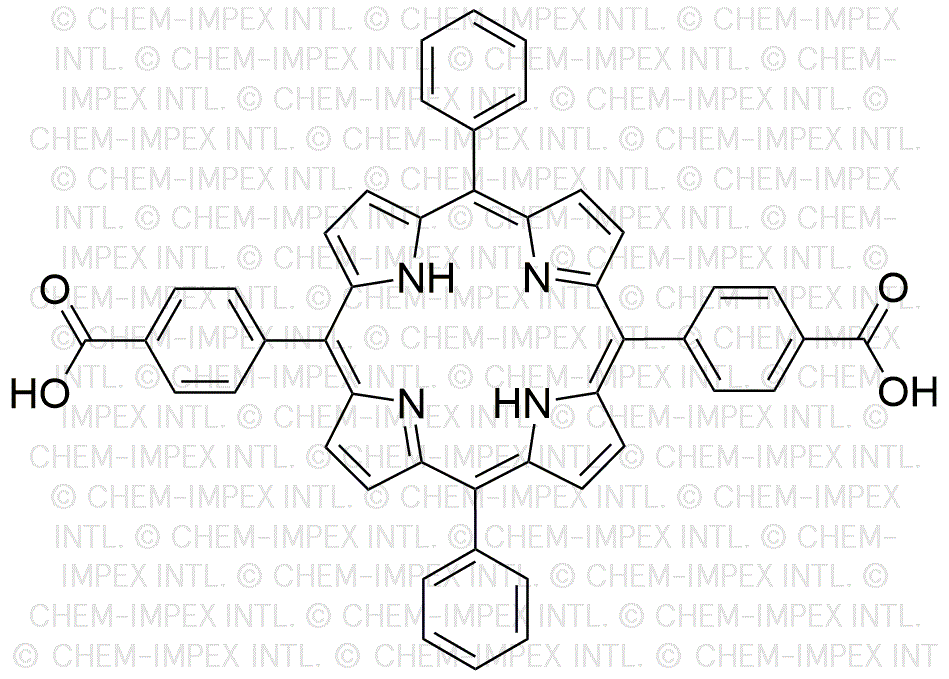5,15-(di-4-Carboxyphenyl)-10,20-(diphenyl)porphyrin is widely utilized in research focused on:
- Photodynamic Therapy (PDT): This compound is effective in treating certain cancers by generating reactive oxygen species when exposed to light, making it a promising agent in cancer treatment protocols.
- Solar Energy Conversion: Its unique structure allows for efficient light absorption, making it suitable for use in organic solar cells, enhancing energy conversion efficiency.
- Fluorescent Probes: The compound serves as a fluorescent marker in biological imaging, aiding researchers in visualizing cellular processes and structures with high precision.
- Catalysis: It can act as a catalyst in various chemical reactions, particularly in organic synthesis, providing an environmentally friendly alternative to traditional methods.
- Sensor Technology: The compound is used in the development of sensors for detecting environmental pollutants, offering a sensitive and selective approach to monitoring air and water quality.
General Information
Properties
Safety and Regulations
Applications
5,15-(di-4-Carboxyphenyl)-10,20-(diphenyl)porphyrin is widely utilized in research focused on:
- Photodynamic Therapy (PDT): This compound is effective in treating certain cancers by generating reactive oxygen species when exposed to light, making it a promising agent in cancer treatment protocols.
- Solar Energy Conversion: Its unique structure allows for efficient light absorption, making it suitable for use in organic solar cells, enhancing energy conversion efficiency.
- Fluorescent Probes: The compound serves as a fluorescent marker in biological imaging, aiding researchers in visualizing cellular processes and structures with high precision.
- Catalysis: It can act as a catalyst in various chemical reactions, particularly in organic synthesis, providing an environmentally friendly alternative to traditional methods.
- Sensor Technology: The compound is used in the development of sensors for detecting environmental pollutants, offering a sensitive and selective approach to monitoring air and water quality.
Documents
Safety Data Sheets (SDS)
The SDS provides comprehensive safety information on handling, storage, and disposal of the product.
Product Specification (PS)
The PS provides a comprehensive breakdown of the product’s properties, including chemical composition, physical state, purity, and storage requirements. It also details acceptable quality ranges and the product's intended applications.
Certificates of Analysis (COA)
Search for Certificates of Analysis (COA) by entering the products Lot Number. Lot and Batch Numbers can be found on a product’s label following the words ‘Lot’ or ‘Batch’.
*Catalog Number
*Lot Number
Certificates Of Origin (COO)
This COO confirms the country where the product was manufactured, and also details the materials and components used in it and whether it is derived from natural, synthetic, or other specific sources. This certificate may be required for customs, trade, and regulatory compliance.
*Catalog Number
*Lot Number
Safety Data Sheets (SDS)
The SDS provides comprehensive safety information on handling, storage, and disposal of the product.
DownloadProduct Specification (PS)
The PS provides a comprehensive breakdown of the product’s properties, including chemical composition, physical state, purity, and storage requirements. It also details acceptable quality ranges and the product's intended applications.
DownloadCertificates of Analysis (COA)
Search for Certificates of Analysis (COA) by entering the products Lot Number. Lot and Batch Numbers can be found on a product’s label following the words ‘Lot’ or ‘Batch’.
*Catalog Number
*Lot Number
Certificates Of Origin (COO)
This COO confirms the country where the product was manufactured, and also details the materials and components used in it and whether it is derived from natural, synthetic, or other specific sources. This certificate may be required for customs, trade, and regulatory compliance.


